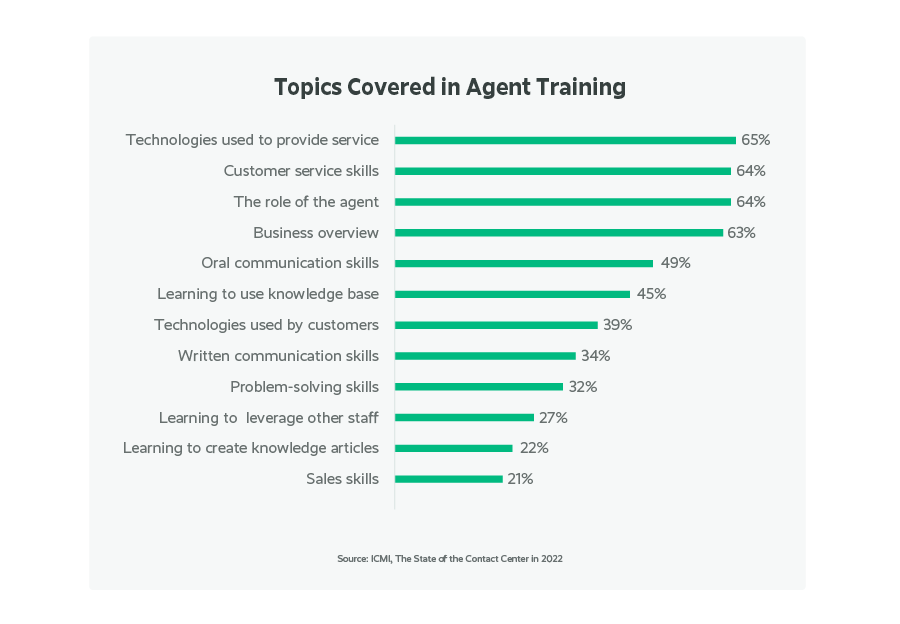Remote Agent Training In Contact Centers: 5 Key Strategies
Let’s confess — we’ve all nodded off during on-demand remote training sessions. The recorded talking-head, one-to-many format is a surefire way to put even the most highly caffeinated employees to sleep. How can you spice up remote agent training at your contact center to make it the most engaging and effective it can be? Here are five winning strategies.

1. Make A Plan
Despite the ongoing debate on the benefits and drawbacks of in-person, hybrid, and remote work, recent data and predictions support remote and hybrid work in a contact center. Experts predict that using remote and hybrid contact center agents will remain a cost-effective, efficient solution for delivering outstanding customer support well into the future.
This staying power means that those in charge of delivering customer experience (CX) need to rethink how they deliver remote training. Step one is to make a plan.
A 2022 ICMI study revealed that 34% of contact centers cited training a remote workforce as their biggest challenge. A solid plan will help you turn this challenge into an opportunity.
First up, what will you cover? ICMI shared that the top skills contact center focused on in agent training were learning the technologies used to provide service, customer service techniques, and the role of an agent. Softer skills fell further down the list.

Next up: How will you tackle remote training? Familiar tactics used for in-person learning may not apply to remote agent training.
You invest heavily in hiring agents who will deliver great CX, so similar time and investment should go into training. Finding the right way to train new representatives and provide ongoing improvement and knowledge will keep them engaged and top performing.
Incorporate these considerations when building your training process and development plan:
- Set learning objectives.
- Align the plan with your organization’s values and culture.
- Make sure all employees understand their role in delivering outstanding CX and have the tools, knowledge, and soft skills to be successful.
- Incorporate feedback. Playvox research shows some disconnect between what agents desire when it comes to proper training versus which elements managers believe are important. Taking the time to incorporate agent feedback helps make your training more effective.
- Leverage a variety of multimedia content, interactivity, and delivery formats.
- Determine upfront how you will measure success.
Related Article: 5 Ways Contact Center Managers are Adapting to Remote Work
2. One Size Does Not Fit All
Studies show that learners need to hear or read something three to seven times to retain the information, and combining visual, written, and audio formats boosts retention.
Ensure your remote agent training takes into account differences in learning styles, format preferences, length of sessions, technical skills, and a host of other considerations when building your remote training tools and content.
Meet your agents where they are, incorporating flexible opportunities and customized learning options found in contact center software for a modern approach, including:
- Recorded videos: Provide illustrative examples and how-tos versus talking heads.
- One-to-one video training with managers: Establishes two-way communication and builds rapport and trust.
- Remote collaboration with managers and peers: Allows “show and tell,” live Q&A, and similar interactivity. Collaboration also facilitates team building, connectedness, and a sense of support, especially critical in remote and hybrid customer service environments.
- Robust knowledge library and online resources: Provide ongoing, supplemental support to agents to aid retention and reinforce learning.
- Instructor-led virtual classroom: Provides a sense of camaraderie when agents train together and allows for discussion and questions along the way.
- Refresher training: Demonstrates to agents that training and learning is not a “one and done” but rather an investment. Communicate the importance of continual improvement, ongoing training, and growth opportunities, which contribute to employee retention.
Related Article: Best Contact Center Software for Remote Workers
3. Engagement. Engagement. Engagement.
To combat the ho-hum of training remotely, go overboard with ways to engage agents and help desk employees.
The more you make the training fun and interactive — and incorporate real-life scenarios — the better the experience and, ultimately, the better the retention. Here are some ideas:
- Incorporate gamification into your agent training and professional development program. This has been shown to not only boost proficiency but it can also be used to uncover knowledge gaps that can be addressed through refresher sessions and additional 1:1 training.
- Leverage polls, quizzes, and chat features found in contact center software and remote collaboration tools. This allows you to gauge knowledge and progress in real-time and encourages active participation.
- Provide opportunities to role-play on video with peers and managers. This boosts confidence and incorporates real-life scenarios into the training.
- Allow ample opportunities for agents to ask questions within a group setting and 1:1. Set the stage by encouraging questions at the beginning of the training.
- Seek feedback and “read the room” throughout the training. Be flexible to adapt to individuals’ preferences and needs. Do frequent check-ins on what’s resonating, what isn’t clear, and when to interject fun and engaging activities and breaks.
4. Measure And Fine-Tune
Successfully delivering training remotely is an iterative process. Whether you’re providing coaching, training new agents, or doing a skills refresher for your existing staff, you need the right tools to measure progress and effectiveness.
- Ask for immediate feedback to gauge satisfaction via an online survey or a 1:1 call or chat. Document the feedback.
- Leverage analytics to measure success and effectiveness against key contact center KPIs.
- Keep the lines of communication open and continue to provide and solicit feedback.
- Determine the timing, format, and adjustments to methodology and/or content for follow-up training.
Related Podcast: Flexibility Isn’t Just for Yoga: Why Contact Center Agents are Demanding Remote Work
5. Invest In Remote Training Technology
Training contact center agents remotely doesn’t need to be daunting. Investing in an agent- and customer-centric technology solution provides the multimedia tools, analytics, and support to make your remote training experience engaging, effective, and customizable.
Remote employees can put down that extra cup of coffee and be engaged and interactive in their learning. This allows them to feel more connected and empowered — and better prepared to deliver outstanding CX.
Likewise, for companies, the investment in a cloud-based remote agent training solution boosts knowledge retention and job satisfaction and ultimately leads to better service delivery.
The remote and hybrid workforce is here to stay. Now is the time to rethink and revamp your training with modern approaches to learning that are sure to make your remote team successful. Request a demo to see how Playvox solutions empower agents to feel engaged in the process and deliver better customer service and support.






